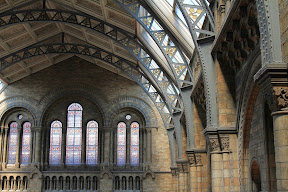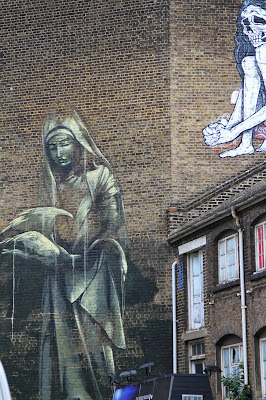Left: Modernism in the Pacific Northwest Brochure Cover (with detail of Moving Moments [1970] by Mark Tobey)
Center: Signs and Messengers [1967] by Mark Tobey
Right: Crane Holding a Snail and Dancing [1945] by Morris Graves

![Signs and Messengers [1967] by Mark Tobey Signs and Messengers [1967] by Mark Tobey](https://blogger.googleusercontent.com/img/b/R29vZ2xl/AVvXsEgIcluFBYCjQir7al_RZxJq-xPEAZ2WdL9UaKjD_t14XfFRooWwFxXfzfobnSFVbH1ODFc1HzHVau6vF0znYwm7E6RbYmeJap4tL36WXngANbYq1hfLDsznj1w_L1g84bQgolGgUp3ZxRU/s400/Signs+and+Messengers+(1967)+-+Mark+Tobey.JPG)
![Crane Holding a Snail and Dancing [1945] by Morris Graves Crane Holding a Snail and Dancing [1945] by Morris Graves](https://blogger.googleusercontent.com/img/b/R29vZ2xl/AVvXsEhqNwhUjNYyRytEYBprWZ0FIAmk0zF-fjAbewMDwbv1Bv8V7qk9KGutqFRbCelYVE-dJOFbScAPP9z9GQtiUstfcI-tXcLZetCyY_4Y1eWkLKqAt5_bTZqOHLQ69SFOH5nASel1QWkTVKo/s400/Crane+Holding+a+Snail+and+Dancing+(1945)+-+Morris+Graves.JPG)
The exhibition Modernism in the Pacific Northwest: The Mythic & the Mystical contains many interesting pieces from the Marshall and Helen Hatch Collection. The Hatchs started collecting Northwest art in the 1970s and donated the collection to the Seattle Art Museum in 2009. They knew many of the artists personally. The artists included in the exhibit are Mark Tobey (1890 – 1976), Morris Graves (1910 – 2001), Kenneth Callahan (1905 – 1986), Guy Anderson (1906 – 1998), Tony Angell (1940 - ), George Tsutakawa (1910 – 1997), and Philip McCracken (1928 - ). An interesting note is that many of the artists included in the exhibit worked at or for the Seattle Art Museum.
Subtitles like The Mythic & the Mystical could be enough to put you off from seeing this this exhibition, but don’t. It’s actually an interesting exhibit. It makes up for the bit of a snooze that was the last exhibit at SAM: Miró: The Experience of Seeing – Seattle Art Museum.
What is modernism? As one site put it, “modernism is notoriously difficult to define clearly because the term encompasses a variety of specific artistic and philosophical movements…”. I think this aspect defined in the Wikipedia page for Modernism is a pretty good starting point for the purposes of this exhibit:
“[modernism] includes the activities and creations of those who felt the traditional forms of art, architecture, literature, religious faith, philosophy, social organization, and activities of daily life were becoming outdated in the new economic, social, and political environment of an emerging fully industrialized world.”As for dates, modernism began in the late 19th century and carried on into the 20th century. The artists in this exhibition began creating art in the 1920s onward, developing a variation of Modernism that employed the symbolic abstract art of the Native Americans of the Northwest and Asian art. For a brief period, Tobey, Morris, Graves, Callahan, and Anderson were at the forefront of Modernism before the spotlight shifted east to the New York artists, like Hans Hoffman (1980 – 1966) and Jackson Pollock (1912 – 1956).
Favorites
Morris Graves was definitely the artist we were most intrigued with in the exhibit. Many pieces on display powerfully express his views about war, for example, confusion and devastation in Oh, Where are the Bright Birds [1944] (Charcoal, ink, and transparent and opaque watercolor on Japanese paper, mounted on linen), and hope at the end of the war with an unlikely dance (peace) between a crane and a snail in Crane Holding a Snail and Dancing [1945] (Opaque and transparent watercolor on gold-toned paper).
Is Moor Swan [1933], an earlier piece featuring a black swam, a metaphor for being gay? We knew Graves was gay (through information at the exhibition) and later learned (according to this article: Gay Mystic Painters) that Tobey and Anderson were also gay.
Perhaps two works by Graves that really stood out where: Spring with Machine Age Noise [1957] (Sumi ink on Chinese paper) and Spring with Machine Age Noise, No. 3 [1957] (Ink, transparent and opaque watercolor on paper). The description to these works includes this: “There is a strip at the bottom of some of the paintings with a little indication of the movement of spring, but the rest of the painting is given over to noise –discordance- nature violated – aggressive machine noise.” YES! Perhaps someone to consider for my Just-Say-No-To-Noise club (a la Noise and Nuisance; Bronzino to Babbage).
Finally, we’ll mention Leo Kenney who, as an information card put it, “painted his own lamentation for the end of the world and then his own retreat into the realm of imagination under the influence of mescaline.” It shows in works like Metamorphosis [1948] (Ink and gouache on Chinese paper) and Voyage for Two [1953] (Gouache on Chinese paper).
Left: Modernism in the Pacific Northwest Exhibit Wall
Center: Broadway Girl [1957] by Mark Tobey
Left: E Pluribus Unum [1942] by Mark Tobey

![Broadway Girl [1957] by Mark Tobey Broadway Girl [1957] by Mark Tobey](https://blogger.googleusercontent.com/img/b/R29vZ2xl/AVvXsEh8G4Q_2M7qcd2aHzlRlMHjv4_IxScpNbqstlH-xTm0bTTotIpWNW9YM7So4edW9TecXqnseTE-RqZQLRmrgKqXzFOb5qelbmYUQJxOX1q_UlnFfdvOP20iG-PvnxCJjcKbyEBV4NfX42k/s400/Broadway+Girl+(1957)+-+Mark+Tobey.JPG)
![E Pluribus Unum [1942] by Mark Tobey E Pluribus Unum [1942] by Mark Tobey](https://blogger.googleusercontent.com/img/b/R29vZ2xl/AVvXsEhR2Ifq4uvBUJzjr_6DGFZXF21e1HtiIz9zjJLMpFDDMzRTbsqqYrL1XvwFDeqcSWeq_e89MUd3B5YfV7CQ2A8K7zq_LPCo1dQk8g3XLCg-252ZywG2GKucy9r4fw56dFWVOql-vS6vaIs/s400/E+Pluribus+Unum+(1942)+-+Mark+Tobey.JPG)
Left: Moor Swan [1933] by Morris Graves
Right: Oh, Where are the Bright Birds [1994] by Morris Graves
![Moor Swan [1933] by Morris Graves Moor Swan [1933] by Morris Graves](https://blogger.googleusercontent.com/img/b/R29vZ2xl/AVvXsEgdEPIujIqRXkN_P-Tu4QxS7vn9dw4-rLQXXyAOxr_RYI9Pn44MbSxaYVnA51NryiAWDcX64G43-rhsPHATCkcKFxQXo5xWFizlPwUlRSIdTBAE-S1HJKc9sOSgLkTvyf7HKzrwJBtlBDk/s400/Moor+Swan+(1933)+-+Morris+Graves.JPG)
![Oh, Where are the Bright Birds [1994] by Morris Graves Oh, Where are the Bright Birds [1994] by Morris Graves](https://blogger.googleusercontent.com/img/b/R29vZ2xl/AVvXsEgyYSvWgxTXWcfWrcu544fLOk11c5WJfe53kZ7SMbv73OFv5deOA2ZDoNU4awVj8TcUkbLv07xw2fwvTz5gALYv3vczOBPQmSJ8CpYhq2AhL01uMQD0dOCDDao05MlZ9GVEkQZAClhjQYI/s400/Oh,+Where+are+the+Bright+Birds+(1944)+-+Morris+Graves.JPG)
Left: Spring with Machine Age Noise [1957] by Morris Graves
Right: Spring with Machine Age Noise, No. 3 [1957] by Morris Graves
![Spring with Machine Age Noise [1957] by Morris Graves Spring with Machine Age Noise [1957] by Morris Graves](https://blogger.googleusercontent.com/img/b/R29vZ2xl/AVvXsEiB3pmFAOoX2CoYDzUDlzYawnIXq5vF5spH1KFq8YhAlHC8NFBY_7iB4EGoBaw9E4NZ7RGYsxNnHZFPxPYOuSRdPfexVyAYjsJToHXx4MN85VEoUz-D6MLtRGxMgVoG6pi_GvPO0nqQ4zs/s400/Spring+with+Machine+Age+Noise+(1957)+-+Morris+Graves.JPG)
![Spring with Machine Age Noise, No. 3 [1957] by Morris Graves Spring with Machine Age Noise, No. 3 [1957] by Morris Graves](https://blogger.googleusercontent.com/img/b/R29vZ2xl/AVvXsEi2pihLf81S5pu4LcONR90ziN3IHLP24lLi9gxwMValATkt7q-ndI8d_jzJoRdQ9lVOGVMdg02ww5EdHf-eF-ITXT5luHVXt2cjwAph4DfcD9jZ_CRMz2fAJ8Fv0dlN7kqOmEEJnpeK1xc/s400/Spring+with+Machine+Age+Noise+3+(1957)+-+Morris+Graves.JPG)
Left: Metamorphosis [1948] by Leo Kenney
Right: Voyage for Two [1953] by Leo Kenney
![Metamorphosis [1948] by Leo Kenney Metamorphosis [1948] by Leo Kenney](https://blogger.googleusercontent.com/img/b/R29vZ2xl/AVvXsEh7RGrW5oRADwMpYIV8pcG5sqLCKRYVD5gNrunDmLFSH3g3qX9FMYzBG4Z8d73Cknr8B8-qSEYSXrFVasG72A1Li_45Dys6P_d-DOPY8xQwuC3vRLV4HCFQ2hIl88WK_ic3BjQDr7xVw3U/s400/Metamorphis+(1948)+-+Leo+Kenney.JPG)
![Voyage for Two [1953] by Leo Kenney Voyage for Two [1953] by Leo Kenney](https://blogger.googleusercontent.com/img/b/R29vZ2xl/AVvXsEhkGKxsXbyji3dbpqeVqmL6HmB2zZeZkipNl4LdM7mdkurfbvD-cfLq_oo7jCqSpaEsEbYz4W3vXXqX4DWI-G2VAHhI0qB0dZdh2AA5FTGP5nQ1E1nE38eJlm7NvDK7VklH7V_b9UMvON4/s400/Voyage+for+Two+(1953)+-+Leo+Kenney.JPG)






+Gallery.JPG)
+Gallery2.JPG)

































































